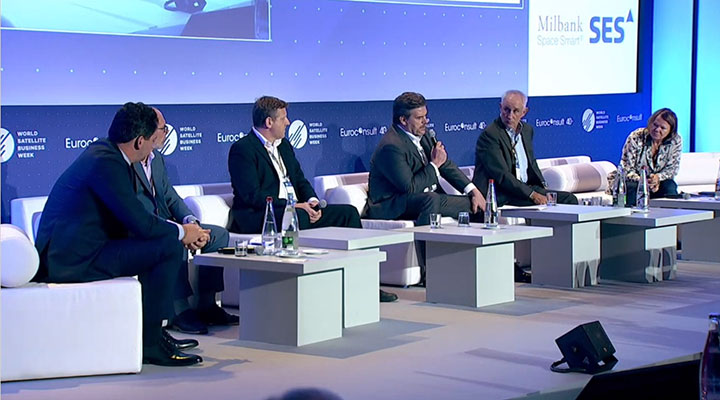 As satellite operators pursue multi-orbit systems, there are issues to solve with ground infrastructure, including smart user terminals and multi-capable antennas. (Source: Vadim Sadovski/Shutterstock)
As satellite operators pursue multi-orbit systems, there are issues to solve with ground infrastructure, including smart user terminals and multi-capable antennas. (Source: Vadim Sadovski/Shutterstock)
PARIS — Some of the biggest developments in the satellite industry over the past year appear to be pointing to a multi-orbit future: the Eutelsat-OneWeb merger; Viasat’s acquisition of Inmarsat; Intelsat’s ongoing agreement with OneWeb and tentative plans for a MEO constellation; Telesat announcing a launch schedule for Lightspeed; SES nearing service launch for the O3b constellation.
If these actions didn’t speak loudly enough, the message from World Satellite Business Week was clearly in favor of multi-path, multi-orbit communications, supported by increased industry collaboration and interoperability between systems.
According to Intelsat CEO David Wajsgras, customer demand has been a driving factor in the company’s decision to expand beyond GEO. “A few years ago, we were getting a lot of pull from our customers,” he said during an operator’s panel. “It started just in a couple of segments. It’s now across the board for multi-orbit capabilities.”
Across aero and maritime, telecommunications and government, there is concurrent demand for applications and capabilities requiring a combination of orbital characteristics, which is fueling operators to diversify offerings. Additionally, the success of disruptors, like Starlink and NGSO mega-constellations, has also led many in the industry to reevaluate traditional business models.
Wajsgras emphasized the importance of a space and satellite “ecosystem” playing into a larger industry strategy. “Any company that thinks they’re going to fly solo and succeed is delusional,” he said. “It’s all about partnerships and alliances and working together to ultimately serve whoever our customer is.”
Amid dynamic changes in space, Eutelsat CEO Eva Berneke offered her forecast on the next major disruption for the industry. She told Constellations that “a fully integrated multi-orbit offer from ground to the satellite” that is “completely seamless for the customer” would likely be the source of the next big shakeup.
A Multi-Orbit Ground Segment
Even with widespread agreement on the benefits of multi-orbit, multi-path and multi-constellation communications, there are challenges in making that vision a reality, particularly from the perspective of the ground segment.
During a panel on ground segment integration, several technology and service providers noted that one of the biggest challenges for their part of the satellite ecosystem would be collaborating to provide the kind of interoperability that customers have come to expect in a communications service. “I think that’s honestly going to be our biggest challenge: is deciding to work together, adopting standards and actually implementing those standards,” said ST Engineering iDirect CEO Don Claussen, citing the model adopted by mobile wireless operators.
Comtech Chief Growth Officer Nicole Robinson agreed that “working together is absolutely key” in terms of adopting standards and speaking with a “unified voice” as an industry. “From the customers’ perspective, interoperability is particularly important,” she added.
Reaching an agreement on standardized ground network technology as a unifying factor is just one piece of the puzzle. Antennas and terminals are also critical and raise the additional challenge of affordability.
SpaceBridge Chief Commercial Officer Javier Recio acknowledged there is pressure to have solutions that work for multiple orbits and satellite systems, but he warned against moving toward increasingly complex, costly commercial terminals.
“This industry, especially on the ground segment, has been, for decades, trying to pursue one thing, which is to have a cheaper terminal,” he said. “If we complicate things, we’re going to go against that and we’re going to have expensive terminals.” antennas could reverse the long-term trend in driving down the cost to more affordable ground infrastructure.
He encouraged hardware providers to “keep it simple,” noting that many customers will be satisfied with a LEO or GEO solution and may only need a single orbit for their use case.
The Capability-Cost Tradeoff
Terminal costs continue to present a barrier to fully unlocking the potential of NGSO constellations. Some providers have begun to reduce the price of flat panel antennas (FPAs) for tracking multiple satellites, but it is far greater than traditional parabolic antennas. As Euroconsult noted in its 2023 Ground Segment Market Report, until those prices come down through commercialization and high-volume production, FPAs will be less appealing to price-sensitive customers.
 Antenna and terminal manufacturers address multi-orbit capabilities during a panel titled Smart Antennas for the Digital Future, Monday, Sept. 11, 2023 at World Satellite Business Week, Paris, France. (Source: Screenshot WSBW/Euroconsult)
Antenna and terminal manufacturers address multi-orbit capabilities during a panel titled Smart Antennas for the Digital Future, Monday, Sept. 11, 2023 at World Satellite Business Week, Paris, France. (Source: Screenshot WSBW/Euroconsult)
Companies building multi-orbit antennas and terminals acknowledged that there is a tradeoff between cost and advanced capabilities. “You have a lot of customers that want a lot. And the more the want is, the more the cost is,” said Kymeta CEO Walter Berger in a panel on smart antennas for the digital future. Kymeta plans to launch its first multi-orbit flat panel terminal for GEO, OneWeb in LEO and cellular networks later this year.
The cost calculus is different between customers. A defense customer in need of “mission critical” MILSATCOM capabilities will be less price sensitive than a commercial operator trying to close a business model. Kymeta is working with operators to “optimize the attributes” of its high-end software-defined platform “to the lowest cost,” which can help create new market opportunities. “It’s really going to come down to a price point, otherwise those markets are not going to open up.”
It’s unclear what the timeline will be for more affordable, multi-capable terminals. Some in the industry are optimistic that Moore’s Law will prevail and more capable, less expensive antenna technology can emerge relatively quickly. Tom Choi, the Executive Chairman of AirspaceIX and Saturn Satellite Networks, and self-proclaimed GEO-phile, is optimistic about the outlook for multi-orbit connectivity.
“I think within the next year, you’re going to see a sub-$2,000 terminal that’s going to be introduced to the market that can provide a multi-megabit link to a GEO satellite as well as connect to a LEO satellite or MEO,” he said during a fireside chat at WSBW. “Even though the satellite operators have not been building that, I think that kind of technology will soon be on the market.”
Collaboration as a Differentiator
The consolidation of the industry, including mergers and partnerships among GEO, LEO and MEO operators, has created its own advantages, according to some industry leaders.
ALL.SPACE CEO John Finney noted that the potential for non-vertically integrated providers to aggregate assets and capacity across orbits would be a differentiating factor over the go-it-alone approach of vertically integrated competitors, like Starlink. For example, an aero customer may want the benefits of live TV and high-speed internet. “You can’t get that from any one part of the system,” Finney said. That use case calls for industry collaboration to “converge all of the capabilities we have to create a high level of differentiation.”
He continued, “We need to innovate but in a collective sense as to what happens when we combine all of the technologies—that ground players have, modem players have, the satellite systems that are in orbit [have]—and really package that.”
Explore More:
Market Dynamics Driving Broadband Providers to Work Together
Podcast: Euroconsult on Satellite Industry Demand Drivers and the $60B Market Opportunity
CEO Insights: Finance, Tech and Disruption
